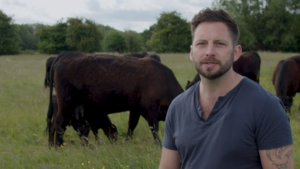Grazing management makes outwintering cattle possible
7th December 2022
A change in grazing management has helped an Oxfordshire farm successfully outwinter cattle and save almost £25,000 in annual winter housing costs.

Farm manager, Silas Hedley-Lawrence says that “Done well, outwintering can help reduce farm costs”.
FAI Farms is preparing to enter its fourth outwintering season – a move farm manager, Silas Hedley-Lawrence says has been made possible through the use of adaptive multi-paddock (AMP) grazing.
“Thinking about outwintering can evoke images of cows standing in a muddy field, eating silage from feeders and knee deep in mud; but there is an alternative, better approach,” says Mr Hedley-Lawrence.
“Done well, outwintering can help reduce farm costs – by reducing labour, fuel, bedding and machinery use – and improve animal wellbeing and soil health.”
AMP grazing – which involves grazing a high density of livestock in a defined area for a short period of time, followed by long rest periods – is being trialled at FAI as part of a project with McDonald’s UK and Ireland.
Mr Hedley-Lawrence says planning is key, especially in the winter months, and consideration must be given to group size, age and nutritional requirements of the cattle, and infrastructure.
He explains that AHDB calculations suggest the daily dry matter intake requirement for cattle under 300kg liveweight is 3% of their body weight, and 2.5% for animals over 300kg liveweight.
“At FAI, we use a 3% figure for all cattle ages and weights as this allows for some flexibility within the system and means there is a buffer in case of bad weather,” adds Mr Hedley-Lawrence.
“Over winter, cows are grazed in cells – small paddocks marked out by temporary electric fences – with each cell containing four or five round bales of hay, which are placed there during the summer.”
He says once the cattle enter a cell, the bales are rolled out for feeding, rather than put in ring feeders, to prevent crowding and poaching.
“We aim for a minimum of 160 cells, for 160 days, at a size of 0.5ha per cell,” explains Mr Hedley-Lawrence.
“We then calculate the estimated available forage against the daily feed requirement of the group and factor in a 75% utilisation rate on available forage; this indicates the deficit needed to be made up by hay bales.”
Although the system required a £6,800 investment in water infrastructure and mobile electric fencing equipment, Mr Hedley-Lawrence says the cost savings from not having to house cattle were approximately £24,163 last winter – this is based on housing 75 suckler cows and calves, and 26 heifers for 180 days.
“The soil type at the FAI Farm is a clay loam and it was never considered suitable for outwintering cattle. However, with some careful planning and regular moves we’ve been able to successfully implement the system on on our land, and if we can do it then any farmer can,” adds Mr Hedley-Lawrence.
“Just go out and try it with a small group by planning and doing the maths; you’ll learn from your mistakes and be able to tweak your plan so you are more and more successful each year with more cows.”
More information about the AMP grazing system at FAI Farms is available online.
